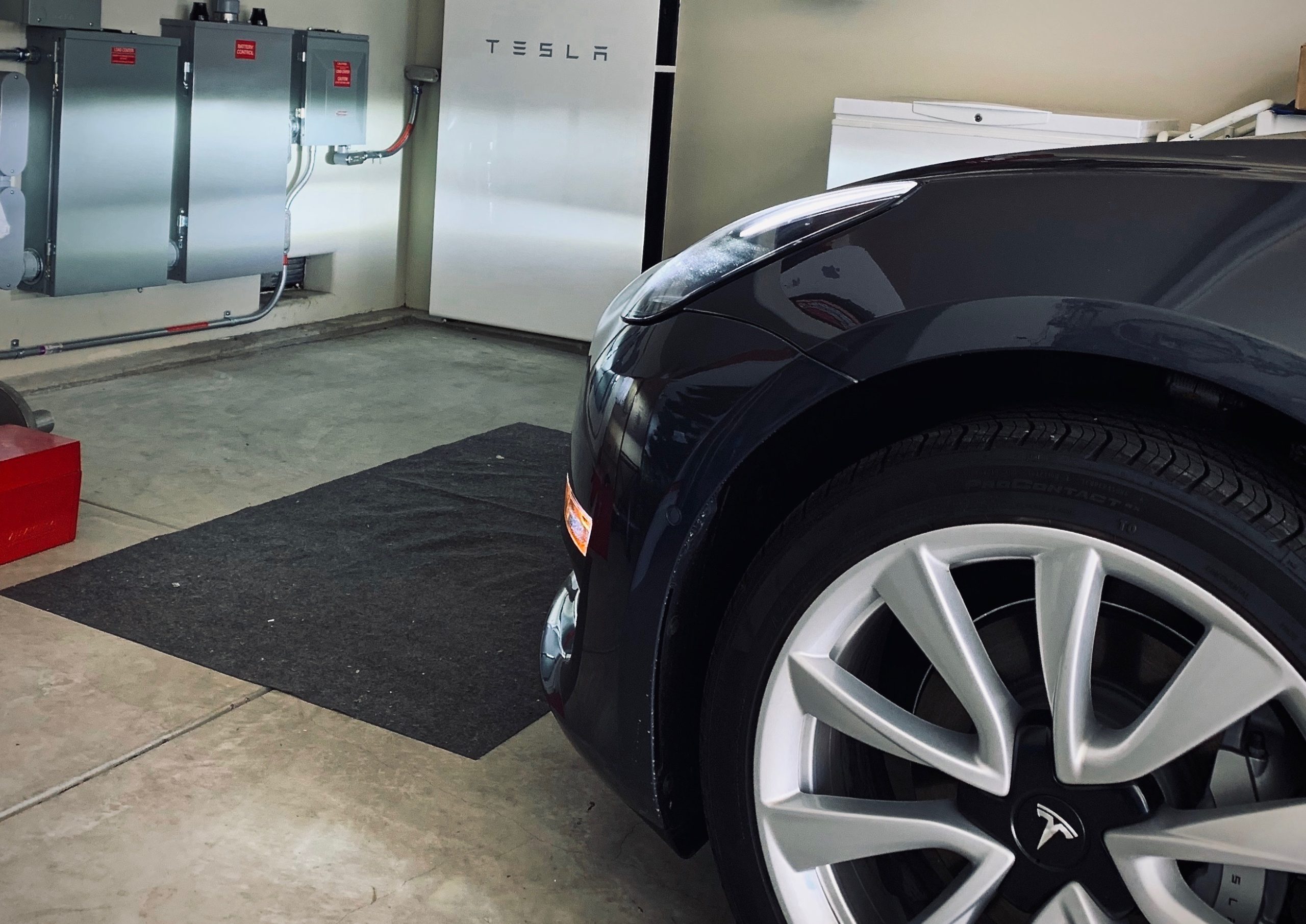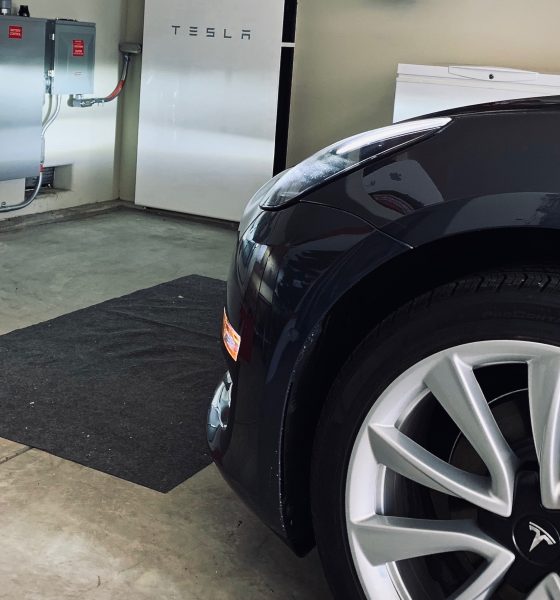

News
Tesla Powerwall smarter integration with vehicle charging hinted at in API code
Recent observations from Tesla’s Powerwall API hint that the company’s electric cars will soon have a feature that will allow them to communicate better with the home battery system. With such a system in place, Tesla’s electric cars will not drain the Powerwall when the grid goes down.
The upcoming Powerwall and Tesla integration feature was first spotted by Model X owner and Reddit user u/cwiedmann.
“Looking through the data returned from the API, I see there’s now evidence of upcoming features for integrating Powerwalls and car charging as Elon mentioned. This appears to be support for preventing car charging from draining the batteries when the grid is down and maybe to allow the car to absorb surplus solar energy,” u/cwiedmann wrote on the r/TeslaMotors subreddit.
When the grid goes down, Tesla Powerwalls can meet the energy demands of a home, including charging an electric car like the Model 3, Model X, or Model S. That being said, there’s a big room for improvement especially when it comes to how a Tesla vehicle communicates with the home battery system. Tesla’s electric cars have massive battery packs after all, and they can drain an off-grid Powerwall if left unattended.
This appears to have happened in May 2019 to Tesla owner Erik Strait, who also runs the YouTube channel DӔrik. Strait brought up the Powerwall issue they encountered in Colorado and suggested features that may come handy to consumers, such as a setting that allows the home battery system to prevent cars charging when they are off the grid. Tesla CEO Elon Musk responded with a brief “Coming soon.”
Coming soon
— Elon Musk (@elonmusk) May 22, 2019
Elon Musk posted his response to the Tesla owner-enthusiast last May, and there have been few updates on the feature since. Nevertheless, references to the feature in the Powerwall’s API today suggests that the home battery-electric vehicle integration may be coming sooner than expected. How the functionality will be rolled out remains to be seen too, but there’s a good chance that Tesla may introduce the feature through an over-the-air update, similar to how the company activates “Storm Watch” for Powerwall-equipped homes located in areas that are facing natural disasters.
Ultimately, the upcoming Powerwall feature shows that Tesla is making a lot of headway in integrating key features of its energy products and its electric cars. This ecosystem could ultimately encourage buyers of Tesla’s electric cars to adopt the company’s energy and battery storage products too, similar to how Apple has encouraged customers to purchase devices within its product line due to their feature integration.
Very early on, we had the ability to use the car as a battery outputting power. Maybe worth revisiting that.
— Elon Musk (@elonmusk) July 4, 2018
These recent observations on the Powerwall API also invoke some thoughts on a feature that was mentioned by Elon Musk back in 2018. In a tweet then, Musk noted that it may be worth revisiting the idea of using its cars as batteries that output power, similar to a V2G (vehicle-to-grid) system. Tesla does seem to be exploring this idea recently, as hinted at by the Cybertruck’s capability to use its massive battery pack to power tools from its onboard outlets.
Teslarati will update you once the Powerwall-Tesla electric vehicle integration feature goes live. For now, this is a welcome development so the habit of “always be charging” does not lead one to a home without power. But of course, there’s always Camp Mode just in case.
Upcoming Powerwall/Vehicle Integration API Leaks from r/teslamotors

Elon Musk
Elon Musk just said some crazy stuff about the Tesla Roadster

Elon Musk appeared on the Moonshots podcast with Peter Diamandis today to discuss AGI, U.S. vs. China, Tesla, and some other interesting topics, but there was some discussion about the upcoming unveiling of the Roadster, the company’s electric supercar that will arrive several years after it was initially slated for release.
Musk made some pretty amazing claims about the Roadster; we already know it is supposed to be lightning-fast and could even hover, if Tesla gets everything to happen the way it wants to. However, the car has some pretty crazy capabilities, some of which have not even been revealed.
On the podcast, Musk said:
“This is not a…safety is not the main goal. If you buy a Ferrari, safety is not the number one goal. I say, if safety is your number one goal, do not buy the Roadster…We’ll aspire not to kill anyone in this car. It’ll be the best of the last of the human-driven cars. The best of the last.”
🚨 Elon on the Roadster unveiling, scheduled for April 1:
— TESLARATI (@Teslarati) January 6, 2026
Musk makes a good point: people who buy expensive sports cars with ridiculous top speeds and acceleration rates do not buy them to be safe. They hope they are safe in case of an emergency or crash, but safety is not at the forefront of their thoughts, because nobody buys a car thinking they’ll crash it.
The Roadster is truly going to push the limits and capabilities of passenger vehicles; there’s no doubt about that. Tesla plans to show off the new version car for the first time on April 1, and Musk has only hinted at what is possible with it.
Musk said back in November:
“Whether it’s good or bad, it will be unforgettable. My friend Peter Thiel once reflected that the future was supposed to have flying cars, but we don’t have flying cars. I think if Peter wants a flying car, he should be able to buy one…I think it has a shot at being the most memorable product unveiling ever. [It will be unveiled] hopefully before the end of the year. You know, we need to make sure that it works. This is some crazy technology in this car. Let’s just put it this way: if you took all the James Bond cars and combined them, it’s crazier than that.”
Production is set to begin between 12 and 18 months after the unveiling, which would put the car out sometime in 2027. Hopefully, Tesla is able to stay on track with the scheduling of the Roadster; many people have been waiting a long time for it.
News
Tesla launches hiring for Robotaxi program in its twentieth country
Overall, the hiring signals Tesla’s aggressive timeline for global dominance in autonomous mobility.

Tesla has launched a hiring initiative for its Robotaxi program in its twentieth country, as the company posted two new jobs in Thailand this week.
Tesla is hiring in Bangkok and Kowloon for the Vehicle Operator position, which is related to data collection, and is the first in Thailand, but the twentieth country overall, as the company tries to expand into other markets.
🚨 BREAKING: Tesla is hiring additional full-time Vehicle Operators in Bangkok, Thailand.
Previous openings were 6-month, part-time roles. These are equivalent to AI Safety Operator roles in the U.S. pic.twitter.com/R6LzoU1bos— Tesla Yoda (@teslayoda) January 5, 2026
Tesla has had active job postings for Vehicle Operator positions in the United States, India, Israel, Taiwan, Germany, the Czech Republic, Hungary, the UK, Finland, Switzerland, Sweden, the Netherlands, Austria, Spain, Norway, Italy, and Turkey in past listings.
These postings are not all currently available, likely because the roles have been filled.
Thailand is the most recent, and broadens the company’s potential path to expanding its ride-hailing program, which is only active in the United States in Austin, Texas, and the California Bay Area, so far.
These roles typically involve data collection, which assists in improving Autopilot and Full Self-Driving operation. Tesla’s self-driving programs utilize real-world data that is accumulated and stored, observing vehicle and traffic behavior, as well as tendencies that are performed by human drivers to help increase safety and overall performance.
Overall, the hiring signals Tesla’s aggressive timeline for global dominance in autonomous mobility. Although the company has several high-profile rivals and competitors in the field, it has established itself as a main player and a leader in the development of autonomous technology, especially in the U.S., as its FSD suite is refined on almost a weekly basis.
The Full Self-Driving suite is available in seven countries and territories currently, including the U.S., Canada, China, Mexico, Puerto Rico, Australia, and New Zealand. Its biggest goal for expansion is currently the European market, where regulatory hurdles have been the main bottleneck prolonging its launch on the continent.
Tesla has performed months of testing in various European countries, including France and Spain, and does have support in some areas from various regulatory agencies. However, the company is hoping to get through this red tape and offer its suite in Europe for the first time, hopefully this year.
News
Tesla China rolls out Model Y upgrades, launches low-interest financing
These strategies are aimed at improving the ownership experience and keeping vehicle pricing competitive in the world’s largest electric vehicle market.

Tesla has rolled out minor updates to the five-seat Model Y in China, upgrading the vehicle’s center display to a higher-resolution 16-inch 2K screen. The electric vehicle maker also introduced attractive financing options, including 7-year low-interest rates, to offset the new purchase tax on EVs.
These strategies are aimed at improving the ownership experience and keeping vehicle pricing competitive in the world’s largest electric vehicle market.
Five-seat Model Y gets larger, better display
With its recent update, all three variants of the five-seat Model Y now feature an upgraded 16-inch 2K resolution center display, which replaces the vehicle’s previous 15.4-inch 1080p panel. This screen was already used in the six-seat Model Y L, and it offered improved visual clarity. Tesla China has also updated the Model Y’s headliner to black, giving the vehicle a sleeker appearance.
Prices of the five-seat Model Y remain unchanged at RMB 263,500, RMB 288,500, and RMB 313,500 for the respective trims. This update enhances the cabin experience as domestic rivals are already adopting high-resolution screens. As noted in a CNEV Post report, some domestic automakers have begun rolling out vehicles equipped with 3K-resolution displays.
New financing offers
Tesla also launched ultra-long-term financing offers for its locally produced models in China, which include the Model 3 sedan, the five-seat Model Y, and the six-seat Model Y L, through January 31, 2026. The 7-year option features an annualized fee rate as low as 0.5%, which is equivalent to 0.98% interest. This is expected to save customers up to RMB 33,479 ($4,790) compared to standard rates.
A 5-year zero-interest plan is also available, and it has been extended to the Tesla Model Y L for the first time. These incentives help offset China’s new 5% purchase tax on New Energy Vehicles (NEVs) in 2026-2027. Some of Tesla’s rivals in China have announced in recent months that they would be covering the purchase tax owed by buyers early this year.








